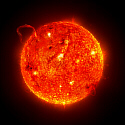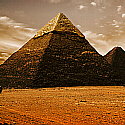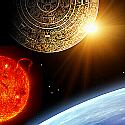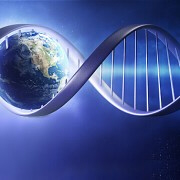Evidence in the Cosmos
Over thirty parameters of the universe have been identified that must be carefully fixed in value for any kind of conceivable life (not just life as we know it) to exist at any time in the history of the universe. Some examples of these are given in Table 1.
Table 1: Evidence for the fine-tuning of the universe
- strong nuclear force constant if larger: no hydrogen; nuclei essential for life would be unstable if smaller: no elements other than hydrogen
- weak nuclear force constant if larger: too much hydrogen converted to helium in big bang, hence too much heavy element material made by star burning; no expulsion of heavy elements from stars if smaller: too little helium produced from big bang, hence too little heavy element material made by star burning; no expulsion of heavy elements from stars
- gravitational force constant if larger: stars would be too hot and would burn up quickly and unevenly| if smaller: stars would be so cool that nuclear fusion would not ignite, thus no heavy element production
- electromagnetic force constant if larger: insufficient chemical bonding; elements more massive than boron would be unstable to fission if smaller: insufficient chemical bonding
- ratio of electromagnetic force constant to gravitational force constant if larger: no stars less than 1.4 solar masses, hence short and uneven stellar burning if smaller: no stars more than 0.8 solar masses, hence no heavy element production
- ratio of electron to proton mass if larger: insufficient chemical bonding if smaller: insufficient chemical bonding
- ratio of number of protons to number of electrons if larger: electromagnetism dominates gravity preventing galaxy, star, and planet formation if smaller: electromagnetism dominates gravity preventing galaxy, star, and planet formation
- expansion rate of the universe if larger: no galaxy formation if smaller: universe collapses prior to star formation
- entropy level of the universe if larger: no star condensation within the proto-galaxies if smaller: no proto-galaxy formation
- mass density of the universe if larger: too much deuterium from big bang, hence stars burn too rapidly if smaller: insufficient helium from big bang, hence too few heavy elements forming
- velocity of light if larger: stars would be too luminous if smaller: stars would not be luminous enough
- age of the universe if older: no solar-type stars in a stable burning phase in the right part of the galaxy if younger: solar-type stars in a stable burning phase would not yet have formed
- initial uniformity of radiation if smoother: stars, star clusters, and galaxies would not have formed if coarser: universe by now would be mostly black holes and empty space
- average distance between galaxies if larger: insufficient gas would be infused into our galaxy to sustain star formation for a long enough time if smaller: the sun’s orbit would be too radically disturbed,
- galaxy cluster type if too rich: galaxy collisions and mergers would disrupt solar orbit if too sparse: insufficient infusion of gas to sustain star formation for a long enough time
- average distance between stars if larger: heavy element density too thin for rocky planets to form if smaller: planetary orbits would become destabilized
- fine structure constant (a number used to describe the fine structure splitting of spectral lines) if larger: no stars more than 0.7 solar masses if smaller: no stars less than 1.8 solar masses if larger than 0.06: matter is unstable in large magnetic fields
- decay rate of the proton if greater: life would be exterminated by the release of radiation if smaller: insufficient matter in the universe for life
- 12C to 16O nuclear energy level ratio if larger: insufficient oxygen if smaller: insufficient carbon
- ground state energy level for 4He if larger: insufficient carbon and oxygen if smaller: insufficient carbon and oxygen
- decay rate of 8Be if slower: heavy element fusion would generate catastrophic explosions in all the stars if faster: no element production beyond beryllium and, hence, no life chemistry possible
- mass excess of the neutron over the proton if greater: neutron decay would leave too few neutrons to form the heavy elements essential for life if smaller: proton decay would cause all stars to rapidly collapse into neutron stars or black holes
- initial excess of nucleons over anti-nucleons if greater: too much radiation for planets to form if smaller: not enough matter for galaxies or stars to form
- polarity of the water molecule if greater: heat of fusion and vaporization would be too great for life to exist if smaller: heat of fusion and vaporization would be too small for life; liquid water would be too inferior of solvent for life chemistry to proceed; ice would not float, leading to a runaway freeze-up
- supernovae eruptions if too close: radiation would exterminate life on the planet if too far: not enough heavy element ashes for the formation of rocky planets if too infrequent: not enough heavy element ashes for the formation of rocky planets if too frequent: life on the planet would be exterminated if too soon: not enough heavy element ashes for the formation of rocky planets if too late: life on the planet would be exterminated by radiation
- white dwarf binaries if too few: insufficient flourine produced for life chemistry to proceed if too many: disruption of planetary orbits from stellar density; life on the planet would be exterminated if too soon: not enough heavy elements made for efficient flourine production if too late: flourine made too late for incorporation in protoplanet
- ratio of the mass of exotic matter to ordinary matter if smaller: galaxies would not form if larger: universe would collapse before solar type stars can form
- number of effective dimensions in the early universe if smaller: quantum mechanics, gravity, and relativity could not coexist and life would be impossible if larger: quantum mechanics, gravity, and relativity could not coexist and life would be impossible
- number of effective dimensions in the present universe if smaller: electron, planet, and star orbits would become unstable if larger: electron, planet, and star orbits would become unstable
- mass of the neutrino if smaller: galaxy clusters, galaxies, and stars will not form if larger: galaxy clusters and galaxies will be too dense
- big bang ripples if smaller: galaxies will not form; universe expands too rapidly if larger: galaxies will be too dense; black holes will dominate; universe collapses too quickly
- size of the relativistic dilation factor if smaller: certain essential life chemistry reactions will not function properly if larger: certain essential life chemistry reactions will not function properly
- uncertainty magnitude in the Heisenberg uncertainty principle if smaller: oxygen transport to body cells would be too small; certain life-essential elements would be unstable if larger: oxygen transport to body cells would be too great; certain life-essential elements would be unstable
- cosmological constant if too large: universe will expand too quickly for solar type stars too form
It is not just the generalized universe that bears evidence for design. The sun and the earth also reveal equally impressive evidence. Some sample parameters sensitive for the support of life are listed in Table 2.
Table 2: Evidence for the fine-tuning of the galaxy-sun-earth-moon system for life support
The following parameters of a planet, its moon, its star, and its galaxy must have values falling within narrowly defined ranges for life of any kind to exist. Characteristics #2 and #3 have been repeated from Table 4 since they apply to both the universe and the galaxy.
- galaxy size if too large: infusion of gas and stars would disturb sun’s orbit and ignite too many galactic eruptions. if too small: insufficient infusion of gas to sustain star formation for long enough time.
- galaxy type if too elliptical: star formation would cease before sufficient heavy element build-up for life chemistry. if too irregular: radiation exposure on occasion would be too severe and heavy elements for life chemistry would not be available.
- galaxy location if too close to a rich galaxy cluster: galaxy would be gravitationally disrupted if too close to very large galaxy(ies): galaxy would be gravitationally disrupted.
- supernovae eruptions if too close: life on the planet would be exterminated by radiation if too far: not enough heavy element ashes would exist for the formation of rocky planets. if too infrequent: not enough heavy element ashes present for the formation of rocky planets. if too frequent: life on the planet would be exterminated. if too soon: not enough heavy element ashes would exist for the formation of rocky planets. if too late: life on the planet would be exterminated by radiation.
- white dwarf binaries if too few: insufficient flourine would be produced for life chemistry to proceed. if too many: planetary orbits disrupted by stellar density; life on planet would be exterminated. if too soon: not enough heavy elements would be made for efficient flourine production. if too late: flourine would be made too late for incorporation in protoplanet.
- proximity of solar nebula to a supernova eruption if farther: insufficient heavy elements for life would be absorbed. if closer: nebula would be blown apart.
- timing of solar nebula formation relative to supernova eruption if earlier: nebula would be blown apart. if later:: nebula would not absorb enough heavy elements.
- parent star distance from center of galaxy if farther: quantity of heavy elements would be insufficient to make rocky planets. if closer: galactic radiation would be too great; stellar density would disturb planetary orbits
- parent star distance from closest spiral arm if farther: quantity of heavy elements would be insufficient to make rocky planets. if closer: radiation from other stars would be too great; stellar density would disturb planetary orbits.
- z-axis heights of star’s orbit if too large: exposure to harmful radiation from galactic core would be too great.
- number of stars in the planetary system if more than one: tidal interactions would disrupt planetary orbits. if less than one: heat produced would be insufficient for life.
- parent star birth date if more recent: star would not yet have reached stable burning phase; stellar system would contain too many heavy elements. if less recent: stellar system would not contain enough heavy elements.
- parent star age if older: luminosity of star would change too quickly. if younger: luminosity of star would change too quickly.
- parent star mass if greater: luminosity of star would change too quickly; star would burn too rapidly. if less: luminosity of star would change too slowly; range of planet distances for life would be too narrow; tidal forces would disrupt the life planet’s rotational period; uv radiation would be inadequate for plants to make sugars and oxygen.
- parent star metallicity if too small: insufficient heavy elements for life chemistry would exist. if too large: radioactivity would be too intense for life; life would be poisoned by heavy element concentrations.
- parent star color if redder: photosynthetic response would be insufficient. if bluer: photosynthetic response would be insufficient.
- H3+ production if too small: simple molecules essential to planet formation and life chemistry will not form. if too large: planets will form at wrong time and place for life.
- parent star luminosity relative to speciation if increases too soon: runaway green house effect would develop. if increases too late: runaway glaciation would develop.
- surface gravity (escape velocity) if stronger: planet’s atmosphere would retain too much ammonia and methane. if weaker: planet’s atmosphere would lose too much water.
- distance from parent star if farther: planet would be too cool for a stable water cycle. if closer: planet would be too warm for a stable water cycle.
- inclination of orbit if too great: temperature differences on the planet would be too extreme.
- orbital eccentricity if too great: seasonal temperature differences would be too extreme.
- axial tilt if greater: surface temperature differences would be too great. if less: surface temperature differences would be too great.
- rate of change of axial tilt if greater: climatic changes would be too extreme; surface temperature differences would become too extreme.
- rotation period if longer: diurnal temperature differences would be too great. if shorter: atmospheric wind velocities would be too great.
- rate of change in rotation period if longer: surface temperature range necessary for life would not be sustained. if shorter: surface temperature range necessary for life would not be sustained.
- age if too young: planet would rotate too rapidly. if too old: planet would rotate too slowly.
- magnetic field if stronger: electromagnetic storms would be too severe. if weaker: ozone shield would be inadequately protected from hard stellar and solar radiation.
- thickness of crust if thicker: too much oxygen would be transferred from the atmosphere to the crust. if thinner: volcanic and tectonic activity would be too great.
- albedo (ratio of reflected light to total amount falling on surface) if greater: runaway glaciation would develop. if less: runaway greenhouse effect would develop.
- asteroidal and cometary collision rate if greater: too many species would become extinct. if less: crust would be too depleted of materials essential for life.
- mass of body colliding with primordial earth if smaller: Earth’s atmosphere would be too thick; moon would be too small. if greater: Earth’s orbit and form would be too greatly disturbed.
- timing of body colliding with primordial earth. if earlier: Earth’s atmosphere would be too thick; moon would be too small. if later: sun would be too luminous at epoch for advanced life.
- 34. oxygen to nitrogen ratio in atmosphere if larger: advanced life functions would proceed too quickly. if smaller: advanced life functions would proceed too slowly.
- 35. carbon dioxide level in atmosphere if greater: runaway greenhouse effect would develop. if less: plants would be unable to maintain efficient photosynthesis.
- 36. water vapor level in atmosphere if greater: runaway greenhouse effect would develop. if less: rainfall would be too meager for advanced life on the land.
- 37. atmospheric electric discharge rate if greater: too much fire destruction would occur. if less: too little nitrogen would be fixed in the atmosphere.
- 38. ozone level in atmosphere if greater: surface temperatures would be too low. if less: surface temperatures would be too high; there would be too much uv radiation at the surface.
- 39. oxygen quantity in atmosphere if greater: plants and hydrocarbons would burn up too easily. if less: advanced animals would have too little to breathe.
- 40. seismic activity if greater: too many life-forms would be destroyed.
if less: nutrients on ocean floors from river runoff would not be recycled to continents through tectonics. - 41. oceans-to-continents ratio if greater: diversity and complexity of life-forms would be limited. if smaller: diversity and complexity of life-forms would be limited.
- 42. rate of change in oceans-to-continents ratio if smaller: advanced life will lack the needed land mass area. if greater: advanced life would be destroyed by the radical changes.
- 43. global distribution of continents (for Earth) if too much in the southern hemisphere: seasonal differences would be too severe for advanced life.
-
44. frequency and extent of ice ages if smaller: insufficient fertile, wide, and well-watered valleys produced for diverse and advanced life forms; insufficient mineral concentrations occur for diverse and advanced life. if greater: planet inevitably experiences runaway freezing.
- 45. soil mineralization if too nutrient poor: diversity and complexity of life-forms would be limited. if too nutrient rich: diversity and complexity of life-forms would be limited.
- 46. gravitational interaction with a moon if greater: tidal effects on the oceans, atmosphere, and rotational period would be too severe. if less: orbital obliquity changes would cause climatic instabilities; movement of nutrients and life from the oceans to the continents and vice versa would be insufficient; magnetic field would be too weak.
- 47. Jupiter distance if greater: too many asteroid and comet collisions would occur on Earth. if less: Earth’s orbit would become unstable.
- 48. Jupiter mass if greater: Earth’s orbit would become unstable. if less: too many asteroid and comet collisions would occur on Earth.
- 49. drift in major planet distances if greater: Earth’s orbit would become unstable. if less: too many asteroid and comet collisions would occur on Earth.
- 50. major planet eccentricities if greater: orbit of life supportable planet would be pulled out of life support zone.
- 51. major planet orbital instabilities if greater: orbit of life supportable planet would be pulled out of life support zone.
- 52. atmospheric pressure if too small: liquid water will evaporate too easily and condense too infrequently. if too large: liquid water will not evaporate easily enough for land life; insufficient sunlight reaches planetary surface; insufficient uv radiation reaches planetary surface.
- 53. atmospheric transparency if smaller: insufficient range of wavelengths of solar radiation reaches planetary surface if greater: too broad a range of wavelengths of solar radiation reaches planetary surface.
- 54. chlorine quantity in atmosphere if smaller: erosion rates, acidity of rivers, lakes, and soils, and certain metabolic rates would be insufficient for most life forms. if greater: erosion rates, acidity of rivers, lakes, and soils, and certain metabolic rates would be too high for most life forms.
- 55. iron quantity in oceans and soils if smaller: quantity and diversity of life would be too limited for support of advanced life; if very small, no life would be possible. if larger: iron poisoning of at least advanced life would result.
- 56. tropospheric ozone quantity if smaller: insufficient cleansing of biochemical smogs would result. if larger: respiratory failure of advanced animals, reduced crop yields, and destruction of ozone-sensitive species would result.
- 57. stratospheric ozone quantity if smaller: too much uv radiation reaches planet’s surface causing skin cancers and reduced plant growth. if larger: too little uv radiation reaches planet’s surface causing reduced plant growth and insufficient vitamin production for animals.
- 58. mesospheric ozone quantity if smaller: circulation and chemistry of mesospheric gases so disturbed as to upset relative abundances of life essential gases in lower atmosphere. if greater: circulation and chemistry of mesospheric gases so disturbed as to upset relative abundances of life essential gases in lower atmosphere.
- 59. quantity and extent of forest and grass fires if smaller: growth inhibitors in the soils would accumulate; soil nitrification would be insufficient; insufficient charcoal production for adequate soil water retention and absorption of certain growth inhibitors. if greater: too many plant and animal life forms would be destroyed
- 60. quantity of soil sulfur if smaller: plants will become deficient in certain proteins and die. if larger: plants will die from sulfur toxins; acidity of water and soil will become too great for life; nitrogen cycles will be disturbed.
- 61. quantity of sulfur in the life planet’s core if smaller: solid core formation begins too soon causing it to grow too rapidly —disrupts magnetic field. if larger: sold inner core never forms—disrupts magnetic field.
- 62. quantity of sea salt aerosols if smaller: insufficient cloud formation and thus inadequate water cycle; disrupts atmospheric temperature balances. if larger: too much and too rapid cloud formation over the oceans disrupting the climate; disrupts atmospheric temperature balances.
- 63. volcanic activity if lower: insufficient amounts of carbon dioxide and water vapor would be returned to the atmosphere; soil mineralization would become too degraded for life. if higher: advanced life, at least, would be destroyed.
- 64. rate of decline in tectonic activity if slower: advanced life can never survive on the planet. if faster: advanced life can never survive on the planet.
- 65. rate of decline in volcanic activity if slower: advanced life can never survive on the planet. if faster: advanced life can never survive on the planet.
- 66. biomass to minicomet infall ratio if smaller: greenhouse gases accumulate, triggering runaway surface temperature increase. if larger: greenhouse gases decline, triggering a runaway freezing.
Table 3: An Estimate of the Probability for Attaining the Necessary Parameters for Life Support
|
PARAM. NUM. |
PARAMETER |
PROBABILITY OF GALAXY, STAR, PLANET, PARAMETER OR MOON FALLING IN REQUIRED RANGE BY CHANCE (WITHOUT DIVINE DESIGN) |
| 1 | galaxy size | 0.1 |
| 2 | galaxy type | 0.1 |
| 3 | galaxy location | 0.1 |
| 4 | star location relative to galactic center | 0.2 |
| 5 | star distance from closest spiral arm | 0.1 |
| 6 | z-axis extremes of star’s orbit | 0.1 |
| 7 | proximity of solar nebula to a supernova eruption | 0.01 |
| 8 | timing of solar nebula formation relative to supernova eruption | 0.01 |
| 9 | number of stars in system | 0.2 |
| 10 | star birth date | 0.2 |
| 11 | star age | 0.4 |
| 12 | star metallicity | 0.05 |
| 13 | star orbital eccentricity | 0.1 |
| 14 | star’s distance from galactic plane | 0.1 |
| 15 | star mass | 0.001 |
| 16 | star luminosity relative to speciation | 0.0001 |
| 17 | star color | 0.4 |
| 18 | H3+ production | 0.1 |
| 19 | supernovae rates & locations | 0.01 |
| 20 | white dwarf binary types, rates, & locations | 0.01 |
| 21 | planetary distance from star | 0.001 |
| 22 | inclination of planetary orbit | 0.5 |
| 23 | axis tilt of planet | 0.3 |
| 24 | rate of change of axial tilt | 0.01 |
| 25 | planetary rotation period | 0.1 |
| 26 | rate of change in planetary rotation period | 0.05 |
| 27 | planetary orbit eccentricity | 0.3 |
| 28 | surface gravity (escape velocity) | 0.001 |
| 29 | tidal force | 0.1 |
| 30 | magnetic field | 0.01 |
| 31 | albedo | 0.1 |
| 32 | density | 0.1 |
| 33 | thickness of crust | 0.01 |
| 34 | oceans-to-continents ratio | 0.2 |
| 35 | rate of change in oceans to continents ratio | 0.1 |
| 36 | global distribution of continents | 0.3 |
| 37 | frequency & extent of ice ages | 0.1 |
| 38 | asteroidal & cometary collision rate | 0.1 |
| 39 | change in asteroidal & cometary collision rates | 0.1 |
| 40 | mass of body colliding with primordial earth | 0.002 |
| 41 | timing of body colliding with primordial earth | 0.05 |
| 42 | rate of change in ast. & comet collision rate | 0.1 |
| 43 | position & mass of Jupiter relative to Earth | 0.01 |
| 44 | major planet eccentricities | 0.1 |
| 45 | major planet orbital instabilities | 0.1 |
| 46 | drift and rate of drift in major planet distances | 0.1 |
| 47 | atmospheric transparency | 0.01 |
| 48 | atmospheric pressure | 0.1 |
| 49 | atmospheric electric discharge rate | 0.1 |
| 50 | atmospheric temperature gradient | 0.01 |
| 51 | carbon dioxide level in atmosphere | 0.01 |
| 52 | oxygen quantity in atmosphere | 0.01 |
| 53 | chlorine quantity in atmosphere | 0.1 |
| 54 | iron quantity in oceans | 0.1 |
| 55 | tropospheric ozone quantity | 0.01 |
| 56 | stratospheric ozone quantity | 0.01 |
| 57 | mesospheric ozone quantity | 0.01 |
| 58 | water vapor level in atmosphere | 0.01 |
| 59 | oxygen to nitrogen ratio in atmosphere | 0.1 |
| 60 | quantity of greenhouse gases in atmosphere | 0.01 |
| 61 | quantity of forest & grass fires | 0.01 |
| 62 | quantity of sea salt aerosols | 0.1 |
| 63 | soil mineralization | 0.1 |
| 64 | quantity of decomposer bacteria in soil | 0.01 |
| 65 | quantity of mycorrhizal fungi in soil | 0.01 |
| 66 | quantity of nitrifying microbes in soil | 0.01 |
| 67 | quantity of soil sulfur | 0.1 |
| 68 | quantity of sulfur in the life planet’s core | 0.1 |
| 69 | tectonic activity | 0.1 |
| 70 | rate of decline in tectonic activity | 0.1 |
| 71 | volcanic activity | 0.1 |
| 72 | rate of decline in volcanic activity | 0.1 |
| 73 | viscosity at Earth core boundaries | 0.01 |
| 74 | biomass to minicomet infall ratio | 0.01 |
| 75 | regularity of minicometary infall | 0.1 |
Dependency Factors Estimate: 100,000,000,000.
Longevity Requirements Estimate: .00001
Probability for occurrence of all 75 parameters: approx. 10 -99
Maximum possible number of planets in universe: approx. 10 22
Much less than 1 chance in a hundred thousand trillion trillion trillion trillion trillion trillion exists that even one such planet would occur anywhere in the universe.






